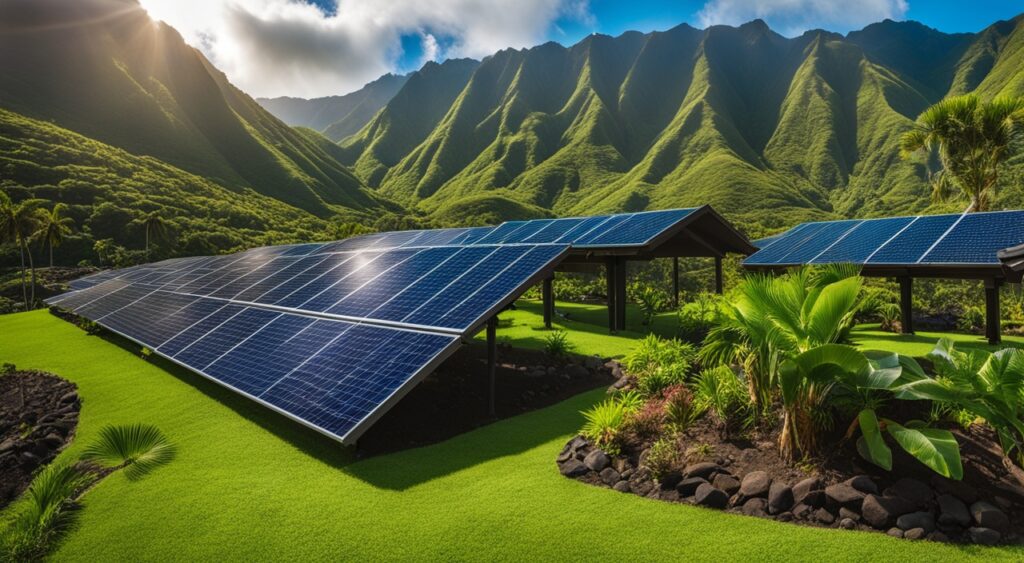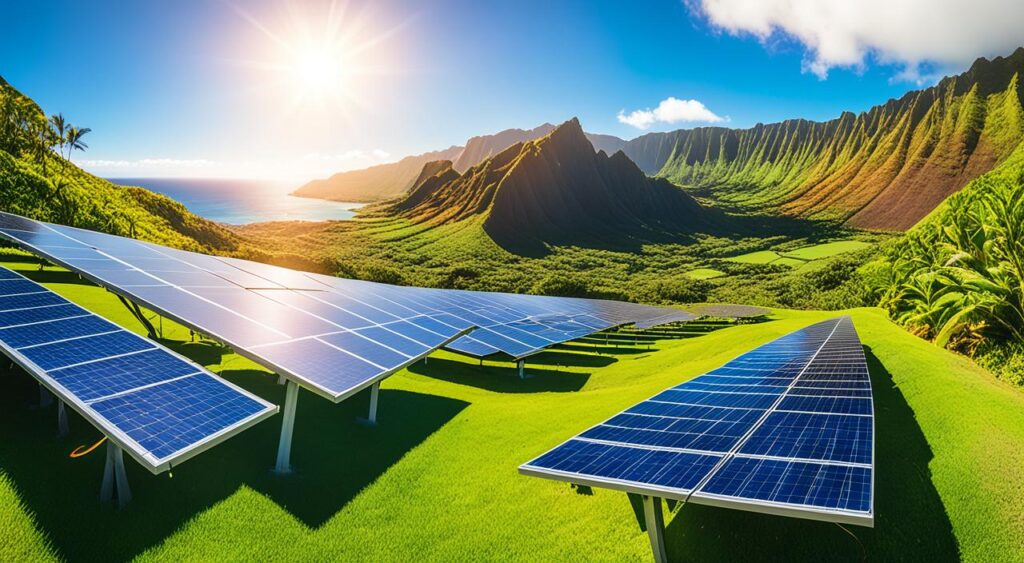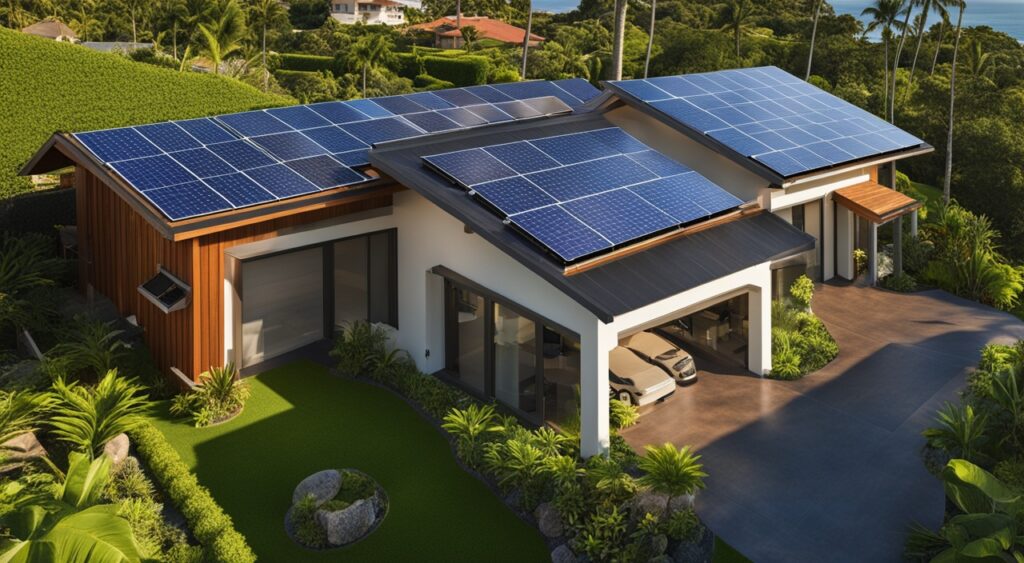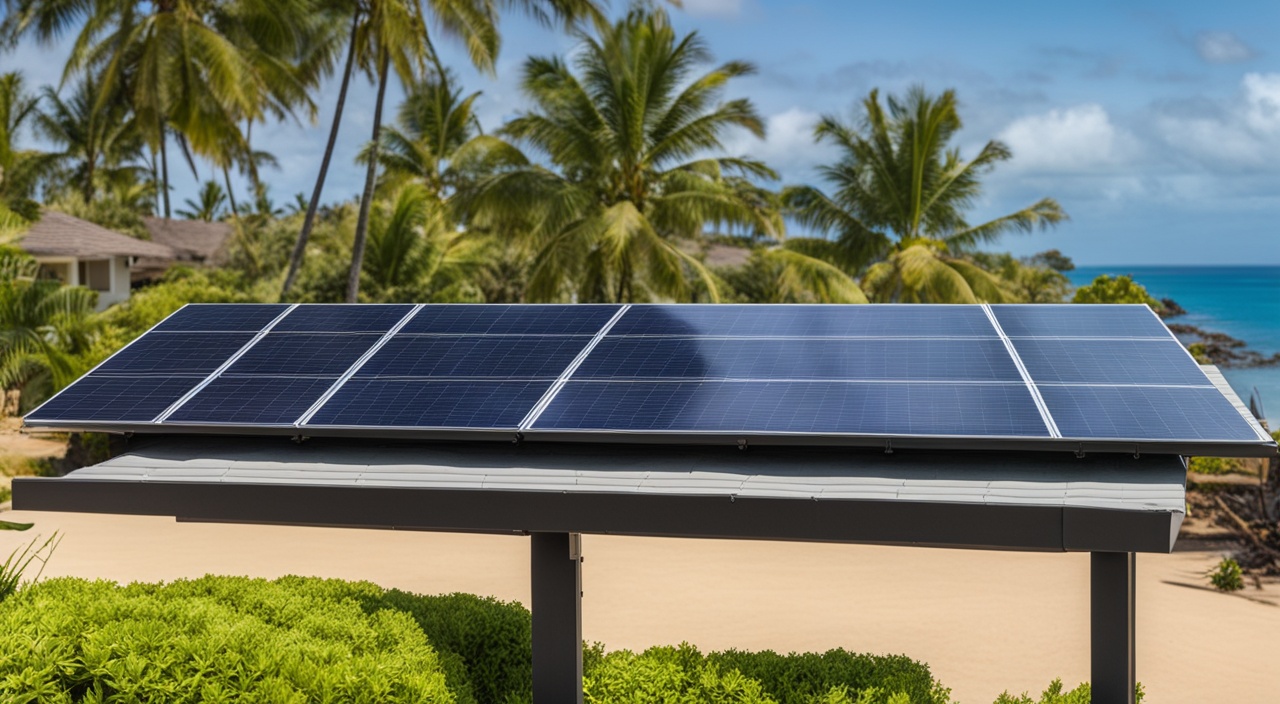Solar Panel Cost in Hawaii
Hawaii is known for its lots of sunshine, making it perfect for solar energy. But, the cost of solar panels in Hawaii can be a big factor for those wanting to switch to renewable energy. This guide will cover the real cost of solar panels in Hawaii. We’ll look at what affects prices, the incentives and financing options, and the benefits of going solar.
Key Takeaways
- Hawaii has some of the highest electricity rates in the country. Solar panels are a smart choice for saving money for both homes and businesses.
- The price of solar panels in Hawaii changes a lot because of the system size, equipment, and installation needs.
- State and federal incentives, like tax credits and rebates, can lower the upfront cost of a solar power system.
- Financing options, such as leases and power purchase agreements, make solar more reachable for people and businesses in Hawaii.
- Switching to solar energy can lead to long-term savings, energy independence, and environmental benefits for Hawaii’s communities.
Why Invest in Solar Panels in Hawaii?
Hawaii is a top spot for solar energy. It has lots of sun and high electricity prices. This makes it a great choice for homeowners and businesses to go solar. Solar power helps save money and supports a greener future.
Abundant Sunshine and High Electricity Costs
Hawaii gets over 270 sunny days a year. This makes it perfect for solar panels. People can make a lot of energy and use less from the grid. Plus, electricity is very expensive in Hawaii, so solar is a smart way to cut costs.
Environmental Benefits and Energy Independence
Getting solar panels in Hawaii saves money and helps the planet. Solar energy doesn’t pollute and uses no fossil fuels. It’s a way for people to fight climate change and be more independent with their energy.
Hawaii solar incentives and Hawaii solar tax credits make solar easier and cheaper to get. These help pay for solar panels upfront. It’s a smart move for those living in Hawaii.
| Benefit | Description |
|---|---|
| Abundant Sunshine | Hawaii enjoys over 270 sunny days per year, making it an ideal location for solar energy generation. |
| High Electricity Costs | Hawaii has some of the highest electricity rates in the nation, providing a strong financial incentive to invest in solar power. |
| Environmental Benefits | Solar energy is a renewable and emissions-free source of power, reducing Hawaii’s carbon footprint and promoting sustainability. |
| Energy Independence | Investing in solar panels in Hawaii allows homeowners and businesses to achieve greater energy independence and control over their electricity costs. |
Using Hawaii’s sun, high electricity prices, and solar incentives, people can make a smart choice. Investing in solar panels in Hawaii helps save money and supports a greener future.

Understanding Solar Panel Cost in Hawaii
The cost of solar panels in Hawaii can change a lot. It depends on many things. When thinking about solar power, knowing what affects the price is key.
The size of the system is a big factor. Bigger systems with more panels cost more. The quality of the solar gear, like panels, inverters, and racks, also matters.
How hard it is to install the system is another big factor. The type of roof, how easy it is to get to the site, and any extra work on the electrical system can increase costs. The location of the place can also matter, especially if it’s hard to get to.
To get a clear picture of what affects the solar panel cost in Hawaii, let’s look at the main factors:
- System size and energy needs
- Solar panel and equipment quality
- Installation complexity and labor costs
- Electrical system upgrades or modifications
- Permits and local regulations
- Geographic location and accessibility
Understanding these factors helps you see the full picture of the solar panel cost in Hawaii. This way, you can make a smart choice for your home or business.

Factors Affecting Solar Panel Cost
When looking at the cost of solar panels in Hawaii, several important factors come into play. Knowing these can help you figure out what you’ll need to spend on your renewable energy system.
System Size and Energy Needs
The size of your solar panel system and your energy use are key factors. Bigger systems for higher energy needs cost more at first. Your home’s size, the number of people living there, and your usual electricity use affect the system size and cost.
Equipment and Installation Costs
The solar equipment you pick, like panels, inverters, and mounts, changes the final price. Also, the installation’s complexity, depending on your location, roof type, and any needed electrical work, can change the total cost of your solar system in Hawaii.
| Factor | Impact on Solar Panel Cost |
|---|---|
| System Size | Larger systems cost more upfront |
| Energy Needs | Higher energy needs require larger, more expensive systems |
| Solar Equipment | Different panel types, inverters, and mounting systems have varying costs |
| Installation Complexity | Factors like roof type and electrical upgrades can increase installation costs |
Understanding these key factors helps you plan and budget for your solar panel setup in Hawaii. This ensures your investment meets your energy needs and fits your budget.

Residential Solar Panel Installation Cost in Hawaii
In Hawaii, the cost to install solar panels at home varies a lot. It depends on your home’s needs and the solar system’s size. We’ll look at the average costs for different system sizes to help you figure out what you might spend.
Average Costs for Different System Sizes
The average cost to install solar panels in Hawaii is between $15,000 and $30,000. This depends on the system’s size. Smaller systems, from 3 to 6 kilowatts (kW), cost about $15,000 to $20,000. Larger systems, from 6 to 10 kW, are usually priced between $20,000 and $30,000.
| System Size (kW) | Average Cost |
|---|---|
| 3-6 kW | $15,000 – $20,000 |
| 6-10 kW | $20,000 – $30,000 |
The actual cost of solar panels in Hawaii can change for many reasons. These include the equipment used, how hard the installation is, and any extra parts needed. Talking to a local solar installer can give you a better idea of what you’ll pay for your specific situation.
Getting solar panels for your home in Hawaii can save you money on energy and help the environment. Knowing the average costs for different sizes helps you choose the best solar option for your house.
Commercial Solar Panel Cost in Hawaii
Businesses in Hawaii are seeing the value in commercial solar panels. The cost of these systems varies a lot. It depends on several things, making it key to know these costs well.
The cost of solar panels in Hawaii changes based on the system’s size, the equipment type, and how hard the installation is. Bigger systems usually cost less per watt. This is because bigger systems get cheaper as they are made in larger quantities.
| System Size | Average Cost per Watt | Total System Cost |
|---|---|---|
| 10 kW | $3.50 – $4.50 | $35,000 – $45,000 |
| 50 kW | $2.75 – $3.75 | $137,500 – $187,500 |
| 100 kW | $2.50 – $3.25 | $250,000 – $325,000 |
These estimates are just rough numbers. The real cost of solar panels in Hawaii can change for many reasons. These include:
- The roof or building’s structure
- Local incentives and tax credits
- The solar company’s reputation and experience
By looking at these factors, businesses in Hawaii can make a smart choice about solar panels. They can see the long-term savings and benefits of solar energy.
“Investing in a commercial solar energy system is a smart business decision in Hawaii. It not only reduces our carbon footprint but also provides long-term cost savings on electricity bills.”
– John Doe, Sustainability Manager at ABC Corporation
Solar Power System Pricing in Hawaii
Hawaii is a great place for solar power because of its sunny weather. But, the cost of solar systems can change a lot based on the technology used. We’ll look at the prices of different solar panel types to help you pick the right one for your energy needs.
Comparing Different Solar Technologies
In Hawaii, you can find many types of solar panels, each with its own benefits and costs. Monocrystalline panels are very efficient and last a long time but are pricier. Polycrystalline panels are less expensive but not as efficient. Thin-film panels are the cheapest upfront but don’t work as well.
- Monocrystalline solar panels: Higher efficiency, more expensive
- Polycrystalline solar panels: Lower efficiency, more affordable
- Thin-film solar panels: Lower efficiency, lower upfront cost
Choosing a solar technology depends on your budget, energy needs, and future goals. Knowing the pros and cons of cost versus performance will help you make a smart choice for your situation.
The final cost of your solar system in Hawaii also depends on the system’s size, installation costs, and any incentives or tax credits you might get. By looking at these factors, you can find the best way to use the sun’s power and lower your energy bills.
Photovoltaic System Cost in Hawaii
Photovoltaic (PV) systems are the top choice for solar power in Hawaii. The cost of these systems depends on panel efficiency, inverter tech, and how hard they are to install.
The price of a PV system in Hawaii is mainly affected by the solar panel’s efficiency. Better panels cost more but make more electricity, which can pay for themselves over time. The inverter technology used also plays a big role in the cost.
How hard it is to install the system is another big factor. If the job needs a lot of roof work, complex wiring, or is in a tough spot, it will cost more. But, easy installs on new buildings or simple roofs can keep costs down.
| Factor | Impact on Photovoltaic System Cost in Hawaii |
|---|---|
| Solar Panel Efficiency | Higher-efficiency panels typically cost more but can generate more electricity, potentially offsetting the initial investment. |
| Inverter Technology | The type of inverter used can significantly impact the overall system cost. |
| Installation Complexity | Projects with extensive roof modifications, complex wiring, or challenging site conditions may incur additional expenses. |
Knowing these factors affecting photovoltaic system cost in hawaii helps people make better choices for their solar energy needs. It also helps them understand the local market better.
Solar Energy System Expense in Hawaii
Investing in solar energy in Hawaii means looking at both the upfront and long-term costs. The initial costs for equipment, installation, and services are high. But, the savings on electricity bills over time can make it a smart choice.
Upfront vs. Long-Term Costs
The initial costs include photovoltaic panels, inverters, racking, and installation labor. These costs change based on the system size, equipment quality, and installation complexity. Yet, the long-term savings often make the investment worth it, as solar power can cut or even eliminate electricity bills for years.
There are also financial incentives and rebates in Hawaii to help lower the upfront costs. This makes solar energy more reachable for homeowners and businesses. By looking at both short-term and long-term costs, you can find the best solar energy solution for your needs.

